Apple iPhone 4S: Thoroughly Reviewed
by Anand Lal Shimpi & Brian Klug on October 31, 2011 7:45 PM EST- Posted in
- Smartphones
- Apple
- Mobile
- iPhone
- iPhone 4S
The A5 Architecture & CPU Performance
The original iPhone debuted with a single 412MHz ARM11 core built on a 90nm process. The 3G improved network performance in 2008 but left the SoC untouched. It wasn't until the iPhone 3GS in 2009 that the SoC got a major performance and power update. Apple moved to a 65nm process node, a brand new ARM Cortex A8 based SoC and an upgraded GPU. The A4 released in 2010 once again gave us a process shrink but kept the architecture unchanged.
Apple's A5, first introduced with the iPad 2, keeps process technology the same while introducing a brand new CPU and GPU. The A5 integrates two ARM Cortex A9 cores onto a single die. The improvement over the A4 is tremendous. At the single core level, Apple shortened the integer pipeline without reducing clock speed. With a shorter pipeline the A5 gets more done per clock, and without decreasing clock speed the A5 inherently achieves better performance at the same clock. The move to the Cortex A9 also enables out-of-order instruction execution, further improving architectural efficiency. I've heard there's a 20% increase in performance per clock vs. the Cortex A8, but combine that with the fact that you get two A9s vs a single A8 in last year's design and you get a pretty big performance increase.
There are several situations where the A5's two cores deliver a tangible performance benefit over the A4's single core. Like Android, iOS appears to be pretty well threaded. Individual apps and tasks can take advantage of the second core without a recompile or version update. The most obvious example is web browsing.
Mobile Safari is well threaded. Javascript rendering can be parallelized as well as parts of the HTML parsing/rendering process. All of the major Javascript performance benchmarks show a 60 - 70% increase in performance over the A4, which is partially due to the availability of the second core:
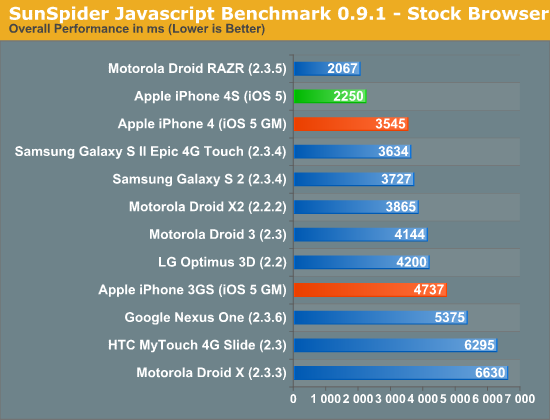
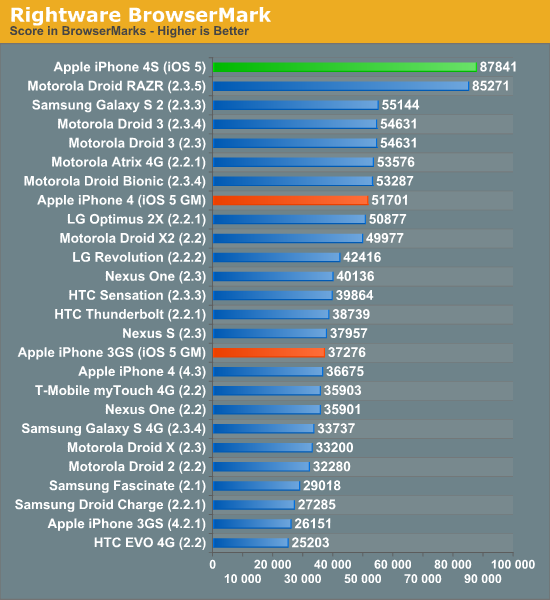
This translates directly into faster page load times. As you can see in the video below, the iPhone 4S (left) loads the AnandTech front page over WiFi in about 5 seconds compared to 9 seconds on the iPhone 4 (right). That's really the best case scenario, the improvement in the next page load time was only about a second (7s vs 8s).
Typical improvements in load time fall in the 10 - 70% range, contributing significantly to the phone feeling snappier than its predecessor. To quantify the improvement I ran through our standard web page loading suite, a test that hits AnandTech, CNN, NYTimes, Engadget, Amazon, Digg and Reddit hosted locally on our lab's network. The average page load time over WiFi for all of the pages is below:
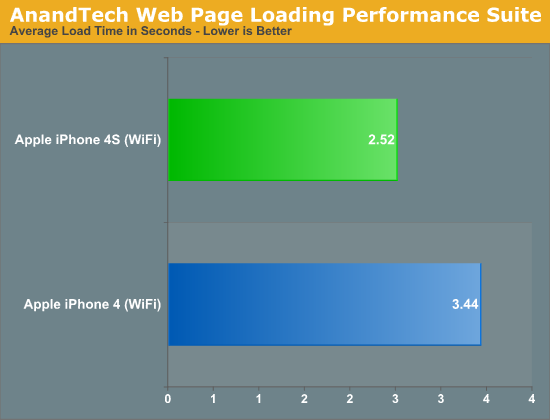
While web page rendering is a natural fit for multiple cores, I was surprised by how poorly threaded some apps ended up being. For example, although I did see performance improvements in exporting edited videos from the iOS version of iMovie, the gains weren't always evident. A quick profile of the app revealed that much of the export process is still single threaded. Just as we've seen on the desktop, there will be some added work necessary to get all apps to utilize multiple cores on iOS.
It's not always performance within an app that saw improvement with the A5: application install and launch times are also much quicker on the 4S. The time to launch Epic's iOS Citadel demo went from 32 seconds on the iPhone 4 to 22 seconds on the 4S. While the iPhone 4 may feel fast enough for many users, the 4S is noticeably faster.
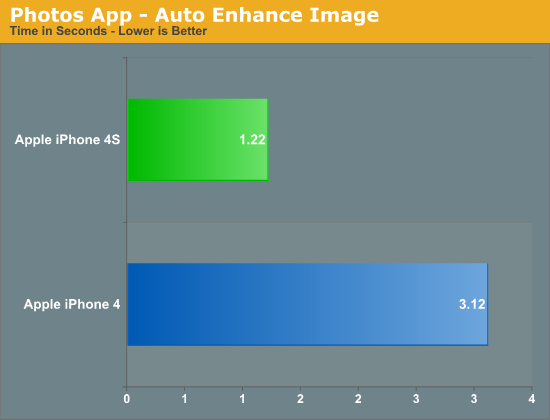
Much of the faster feel comes from by shaving off of seconds here or there. For example, I noticed apps like Messages pop up just slightly quicker on the 4S and you'll see your listing of messages a hair faster than you would on the 4. In the video above you get a brief idea of the sort of subtle improvements I'm talking about. YouTube launches a fraction of a second quicker on the 4S vs the 4.
These subtle decreases in response time are simply icing on the cake. The move from a 4 to a 4S is one of those upgrades that you'll notice right off the bat but will really appreciate if you go back to an iPhone 4 and try to use it. If you do a lot of web browsing on your phone, you'll appreciate the 4S.
I wasn't entirely sure whether or not I could attribute all of these performance improvements to the faster CPU. It's possible that some of the tests I mentioned are IO bound and Apple could have used faster NAND in the 4S. To find out I rounded up a bunch of iPhone 4Ses at all available capacities and measured sequential write speed:
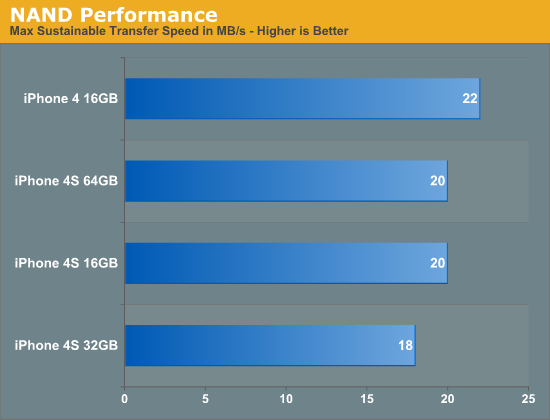
Apple uses multiple sources for NAND so it's possible that you'll see these numbers move around a bit depending on your particular phone. It looks like the iPhone 4S' NAND is no faster than what Apple shipped last year - at least in sequential write speed. The target appears to be 20MB/s and Apple does its best to stay around there. My iPhone 4 is actually pretty quick at 22MB/s but the advantage isn't significant enough to make a huge deal about. I don't have a good way of measuring random IO performance yet but application launch time is largely governed by sequential IO so I don't expect we're seeing gains from anything outside of the CPU and memory bandwidth in the earlier tests.


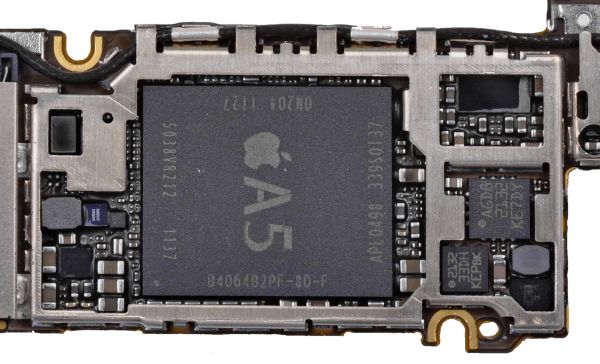








199 Comments
View All Comments
Lucian Armasu - Wednesday, November 2, 2011 - link
Anand, you said the GLbenchmark is the only good cross-platform graphics benchmark. Was GLBenchmark made originally for iOS? Don't you think that it could be biased (possibly unintentionally) towards shader performance in its scores, which would make it favor the PowerVR GPU's more?At the end of the day, these are all just syntethic benchmarks, and sometimes they could be way off from real world performance tests. So what if GLBenchmark doesn't give a too big score for stuff that the other chips are good at, like physics, geometry, whatever, and it gives higher score for shader stuff?
Another question, don't you think shader performance is starting to limit what the games can show about now? Will it really help games that much if they received 20x shader performance in the next 2 years?
thunng8 - Wednesday, November 2, 2011 - link
Glbenchmark was originally release for Linux, Symbian and Windows Mobile.thunng8 - Wednesday, November 2, 2011 - link
Also you do realize that Glbenchmark consists of many tests including some primitive tests like fill rate and Geometry?By other Gpu, do you mean the Mali-400 or GeForce ulp? The standout result I saw was how weak the Mali was at geometry being 4x slower while fill rate was less than 2x slower than the 543mp2
lemmo - Wednesday, November 2, 2011 - link
Thanks for the review, but did I miss analysis on audio quality... for music, not voice quality?You've started this with the Galaxy S2, really useful, and I believe you're developing your testing methodology. But any indication how the iPhone audio quality compares to S2, Prime and others?
cacca - Wednesday, November 2, 2011 - link
if nobody has photo-shopped the images at page 3 i not quite strenge that you have a better throughput.iPhone 4 test done at PM 4.24, a normal afternoon, with quite a lot of traffic
iPhone 4s test done at AM 3.34, a quite early bird, no problems or fight for resources with other phones
To you is normal to test at so different times? An for you there is no difference between a late afternoon and 3.34 in the morning?
bah
koinkoin - Wednesday, November 2, 2011 - link
I was wondering what the battery time is when you call with a headset. I do almost all my call with a headset to keep my hand free (on the wheel or keyboard). How much does this affect the battery time.Also I use a Blackberry and it always check for new email, I sometime read the mail while on the phone, when you do the talk time test is there a connection for email open?
koinkoin - Wednesday, November 2, 2011 - link
I was wondering what the battery time is when you call with a headset. I do almost all my call with a headset to keep my hand free (on the wheel or keyboard). How much does this affect the battery time.Also I use a Blackberry and it always check for new email, I sometime read the mail while on the phone, when you do the talk time test is there a connection for email open?
Griswold - Wednesday, November 2, 2011 - link
I dont think the results the new camera deliver are superior to the one in the iphone4. Judging by the vast number of shots Engadget compared between these two phones and a couple other premium phones, the iphone4s shows alot more noise than the older model, even in broad daylight. Its probably the increased pixel count, which cant be countered by the other improvements.Its not bad, but its also not better than the old camera. The old saying remains true: more pixels doesnt equal better pictures.
jwwpua - Wednesday, November 2, 2011 - link
In the section WIFI, GPS, AUDIO, SPEAKERPHONE, I don't see anything about the speakerphone. Is it louder? Any tests done? Clarity?Thanks, great review!
freezer - Thursday, November 3, 2011 - link
I think you should have the GPU benchmark using phone's native resolution. That would give more accurate results in real world gaming situation than running all phones using same resolution.The iPhone 4S 3.5" screen has much more pixels than Galaxy S2 4.3" screen which gives latter advantage in 3D speed. That is because the GPU has to draw every pixel in every frame. There's no way around it.
In fact running GL Benchmark 2.1 Pro High in native resolution gives very different results as Galaxy S2 comes at top:
http://glbenchmark.com/result.jsp?benchmark=glpro2...